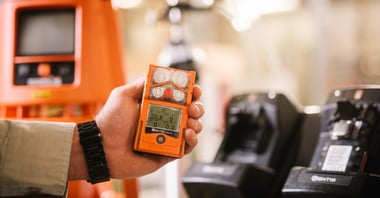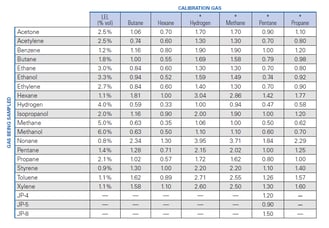Key Takeaways:
- Catalytic Bead vs. IR LEL Sensors: Know the Difference Before You Deploy: Both catalytic bead and infrared (IR) LEL sensors detect combustible gases, but they operate differently and suit different environments.
- IR LEL Sensors Offer Longer Life and Greater Resistance to Contaminants: Unlike catalytic bead sensors, IR LEL sensors don’t require oxygen, aren’t affected by poisons or inhibitors, and consume less power.
- Choose the Right Sensor Based on Your Gas Hazards and Conditions: Catalytic bead sensors are better for detecting gases like hydrogen and acetylene, while IR sensors excel in low-oxygen or high-contaminant environments.
 In the world of industrial safety, effective gas detection can mean the difference between a safe work environment and a catastrophic incident. That's where Lower Explosive Limit (LEL) sensors come into play. Two of the most prevalent technologies—catalytic bead sensors and infrared (IR) LEL sensors—are essential tools for monitoring combustible gases. But how do you decide which is right for your site's needs?
In the world of industrial safety, effective gas detection can mean the difference between a safe work environment and a catastrophic incident. That's where Lower Explosive Limit (LEL) sensors come into play. Two of the most prevalent technologies—catalytic bead sensors and infrared (IR) LEL sensors—are essential tools for monitoring combustible gases. But how do you decide which is right for your site's needs?
What is a Catalytic Bead LEL Sensor?
Catalytic bead (or catalytic diffusion) sensors are among the most widely used technologies for detecting combustible gases. Inside each sensor are two wire-wrapped beads: one active, coated with a catalyst to promote combustion, and one reference, designed to remain inert. When combustible gas enters the sensor, it burns on the heated active bead, causing a temperature rise that alters its electrical resistance. By comparing the resistance between the two beads, the sensor determines gas concentration as a percentage of the LEL.
Limitations of a Catalytic Bead LEL Sensor
Sensor Poison
Sensor poisons are substances that adhere to a catalytic bead sensor and cause permanent damage that prevents it from functioning properly. Some of the most common poisons are silicone-based products (e.g. lotions and hair products), lubricants, gas additives, lead, and sulfur compounds. If any of these poisons encounter the heated catalytic bead, they instantly melt and adhere to the surface. Since this sensor now has a layer of melted poison substance surrounding it, it is no longer able to burn and unable to detect any combustible gas hazards. Once these poisons encapsulate the catalytic bead, there is no way to remove them, and the sensor must be replaced.
Oxygen Requirements
Because combustion takes place within the sensor chamber, the sensor requires a minimum oxygen requirement of at least 10% vol.
Sensor Inhibitors
Inhibitors, while not as destructive as poisons, still have a negative effect on the sensor. Inhibitors can desensitize the bead and may shorten its life span, but after a calibration and bump test, the sensor may still be usable. Some of the most common inhibitors are halogenated compounds as well as anything containing astatine, bromine, fluorine, chlorine, and iodine. If combustible gases and inhibitors are present at the same time, the catalytic bead sensor may not detect the combustible gas.
What is an Ultra-Low Power IR Sensor?
An ultra-low power infrared (ULP IR) LEL sensor, as opposed to a catalytic bead, works based upon the absorption of infrared radiation at specific wavelengths as it passes through a volume of gas.
While both catalytic bead and IR LEL sensors are viable solutions for combustible gases, there are key differences that can make either sensor an ideal solution for your specific gas detection application.
Benefits of Using an IR LEL Sensor
No Oxygen Required
Due to the nature of an IR LEL sensor, oxygen is not required for the sensor to detect combustible gases, making the IR LEL sensor ideal for sampling in inert environments such as confined spaces or lines that are being purged. Since there is no oxygen required, you can sample without additional equipment like dilution tubes. Instead, simply attach the required length of tubing to your aspirated gas monitor and you can begin sampling.
Immune to Poisons and Inhibitors
An IR LEL sensor is not damaged by high gas concentrations, so you can also continue to sample in high LEL environments for prolonged periods of time without damaging the IR LEL sensor. An IR LEL sensor also is not susceptible to poisons and inhibitors that can damage a catalytic bead LEL sensor. Many poisons and inhibitors are products and gases commonly found in environments where gas detection is needed, so you can significantly increase the life of your sensor by choosing an IR LEL sensor.
Extends Battery Life
An IR LEL sensor also takes much less power than a standard catalytic bead sensor, allowing for longer monitor run time. For example, an aspirated Ventis® Pro5 using a catalytic bead LEL sensor can run for 18 hours, while the same configuration with an ULP IR LEL sensor in place of the catalytic bead can run for 32 hours.
Limitations of an IR LEL Sensor
Although an IR LEL sensor has several benefits over a standard catalytic bead LEL sensor, they do have some drawbacks that may not make them suitable for your application.
Gas Blindness
The main drawback is that an IR LEL sensor is blind to some gases, the most common being hydrogen (H2) and acetylene (C2H2). An IR LEL sensor will not detect these gases, so if you have the potential for either to be present in your application, you should not use an IR LEL sensor.
Humidity Sensitivity
An IR LEL sensor can also display false readings due to humidity, especially when moving from cold to warm atmospheres. While these false readings can be a nuisance, they are self-correcting. If readings appear when your monitor moves from a cold to warm and humid atmosphere, the sensor will stabilize on its own.
Which One Should You Use?
Choosing between catalytic bead and IR LEL sensors hinges on your specific operational needs and environmental conditions. Catalytic bead sensors are renowned for their prevalence and reliability in oxygen-rich environments, while IR sensors excel in low-oxygen settings and yield a longer battery life.
Weigh the pros and cons carefully based on your gas detection needs; talk to one of our experts to decide which LEL sensor is better for your operations.



